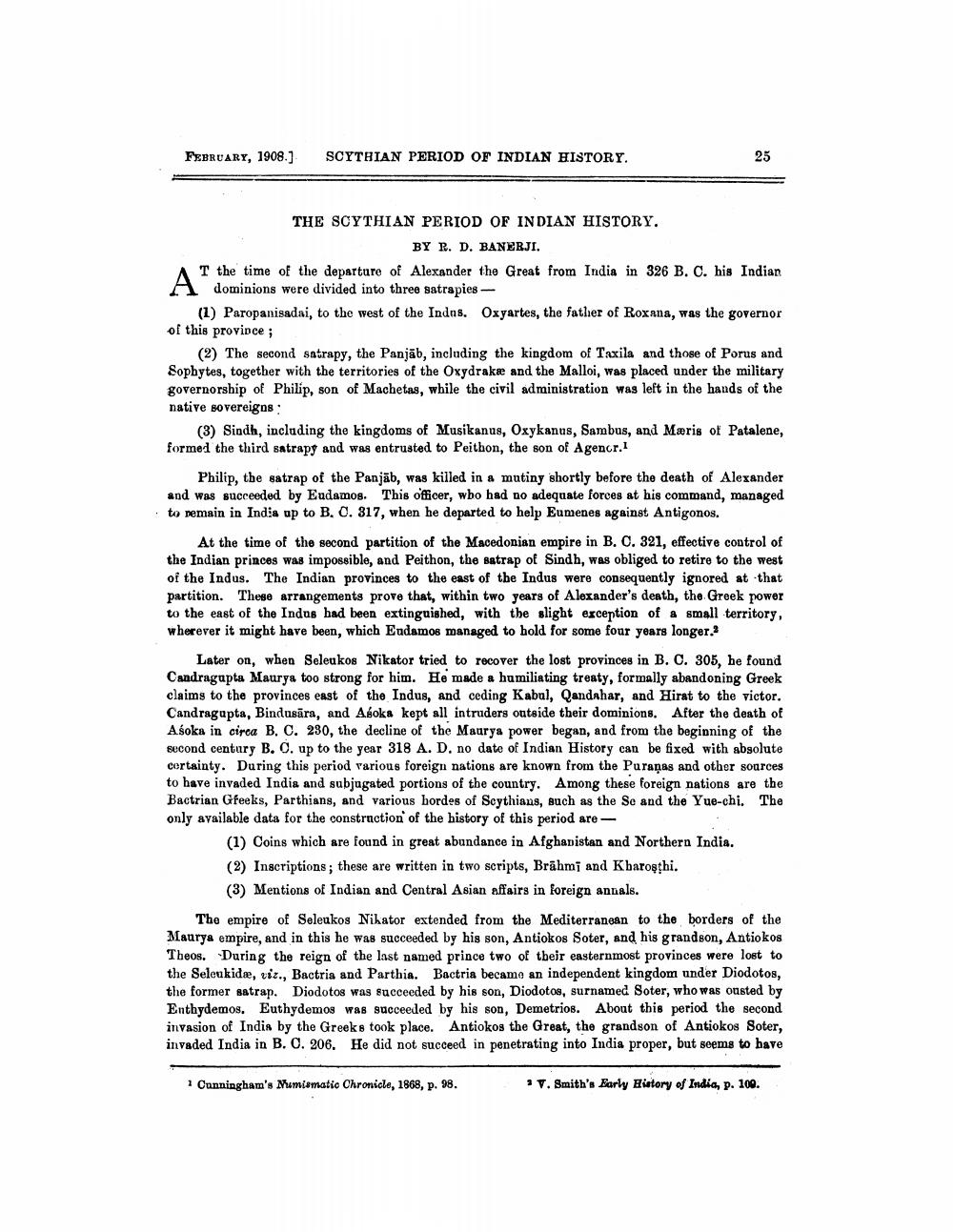________________
FEBRUARY, 1908.)
SCYTHIAN PERIOD OF INDIAN HISTORY.
THE SCYTHIAN PERIOD OF INDIAN HISTORY.
BY R. D. BANERJI. A T the time of the departure of Alexander the Great from India in 326 B. C. his Indian A dominions were divided into three satrapies -
(1) Paropanisadai, to the west of the Indns. Oxyartes, the father of Roxana, was the governor of this province ;
(2) The second satrapy, the Panjāb, including the kingdom of Taxila and those of Porus and Sophytes, together with the territories of the Oxydrakæ and the Malloi, was placed under the military governorship of Philip, son of Machetas, while the civil administration was left in the hands of the native sovereigns
(3) Sindh, including the kingdoms of Musikanus, Oxykanus, Sambus, and Maris of Patalene, formed the third satrapy and was entrusted to Peithon, the son of Agencr.1
Philip, the satrap of the Panjāb, was killed in a mutiny shortly before the death of Alexander and was succeeded by Eudamos. This officer, wbo had no adequate forces at his command, managed • to remain in India ap to B. C. 317, when he departed to help Eumenes against Antigonos.
At the time of the second partition of the Macedonian empire in B. C. 321, effective control of the Indian princes was impossible, and Peithon, the satrap of Sindh, was obliged to retire to the west of the Indus. The Indian provinces to the east of the Indus were consequently ignored at that partition. These arrangements prove that, within two years of Alexander's death, the Greek power to the east of the Indus had been extinguished, with the slight exception of a small territory, wherever it might have been, which Endamos managed to hold for some four years longer.
Later on, when Seleukos Nikator tried to recover the lost provinces in B. C. 305, he found Candragupta Maurya too strong for him. He made a humiliating treaty, formally abandoning Greek claims to the provinces east of the Indus, and ceding Kabul, Qandahar, and Hirat to the victor. Candragupta, Bindusāra, and Aboka kept all intruders outside their dominions. After the death of Asoka in ciroa B, C. 230, the decline of the Maurya power began, and from the beginning of the second century B. C. up to the year 318 A. D. no date of Indian History can be fixed with absolute certainty. During this period various foreign nations are known from the Puranas and other sources to have invaded India and subjugated portions of the country. Among these foreign nations are the Bactrian Gfeeks, Parthians, and various bordes of Scythians, such as the Se and the Yue-chi. The only available data for the construction of the history of this period are
(1) Coins which are found in great abundance in Afghanistan and Northern India. (2) Inscriptions; these are written in two scripts, Brāhmi and Karoghi.
(3) Mentions of Indian and Central Asian affairs in foreign annals. The empire of Seleukos Nikator extended from the Mediterranean to the borders of the Maurya empire, and in this he was succeeded by his son, Antiokos Soter, and his grandson, Antiokos Theos. During the reign of the last named prince two of their easternmost provinces were lost to the Seleukidæ, viz., Bactria and Parthia. Bactria became an independent kingdom under Diodotos, the former satrap. Diodotos was succeeded by his son, Diodotos, surnamed Soter, who was oasted by Enthydemos. Euthydemos was succeeded by his son, Demetrios. About this period the second invasion of India by the Greeks took place. Antiokos the Great, the grandson of Antiokos Soter, invaded India in B. C. 206. He did not succeed in penetrating into India proper, but seems to bave
1 Cunningham's Mumismatic Chronicle, 1868, p. 98.
7. Smith's Early History of Indian p. 100.




